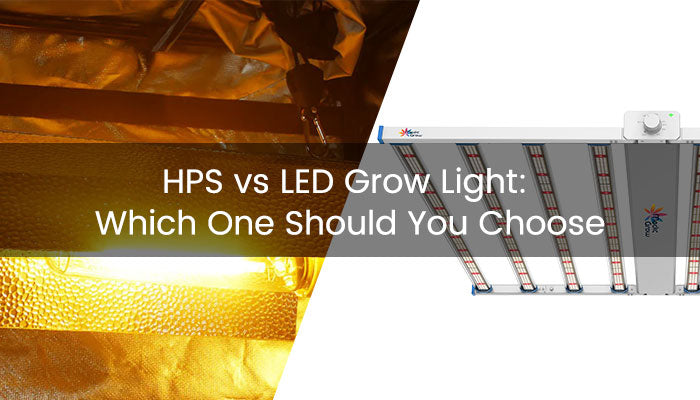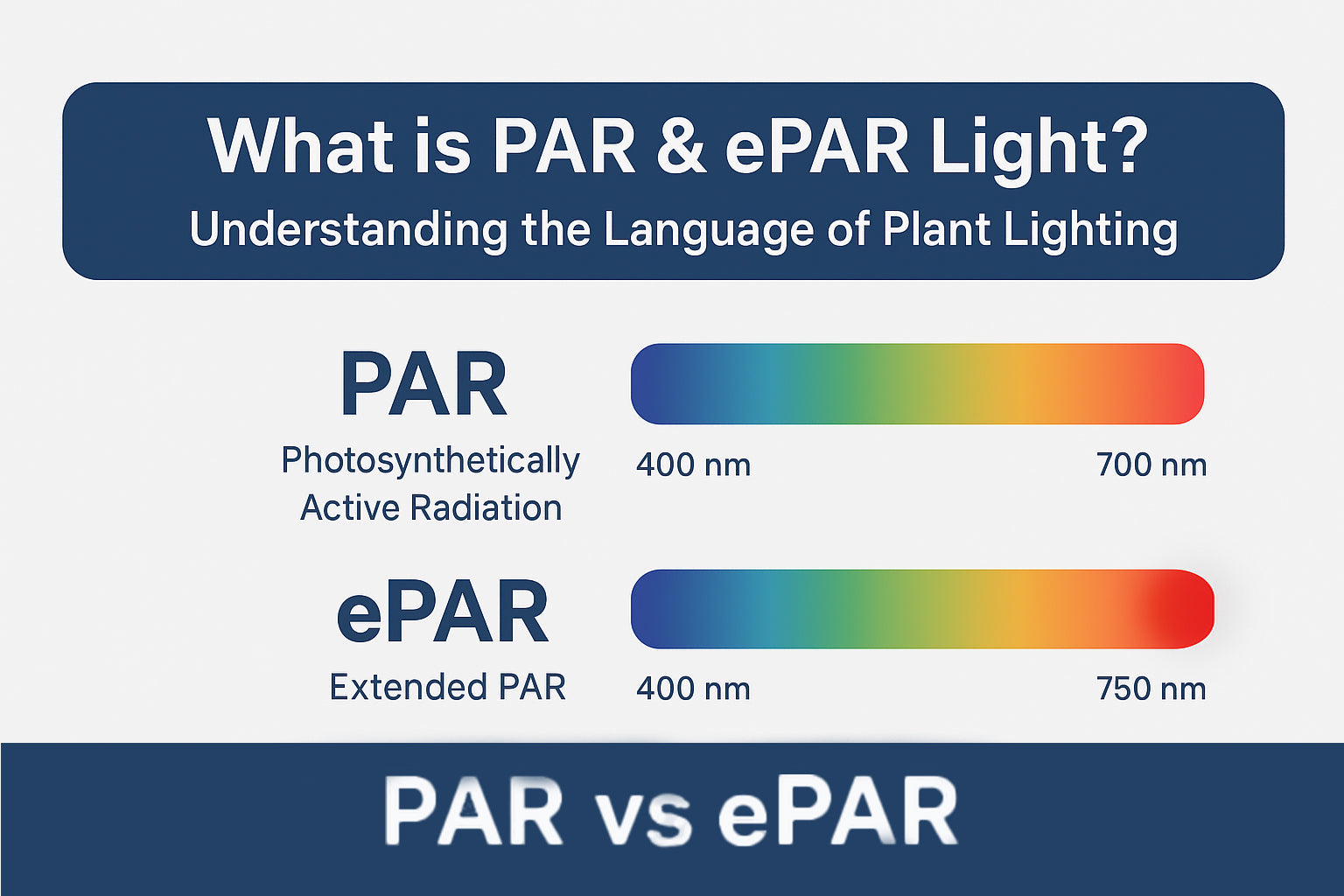
HPS vs LED Grow Light: Which One Should You Choose
HPS vs LED is a long and age-old debate that has been in the limelight since the introduction of LED grow lights. Beginners usually get confused about which light is suitable for their indoor grow area.
In this article, we will discuss the LED vs HPS grow lights 2024 by considering the latest technology and features. We will give a detailed overview of both types of grow lights and discuss their advantages and disadvantages.
After reading this article, you will get an idea of which light is suitable for your grow area. Plus, we will also share the criteria for choosing LED grow lights to help you make the right decision.
Main Content:
- 1. HPS vs LED Grow Light: Take You to Quickly Understand the Definition
- 2. HPS vs LED Grow Light: Advantages and Disadvantages
- 3. How to Choose LED Grow Light?
HPS vs LED Grow Light: Take You to Quickly Understand the Definition
For a better understanding of HPS vs LED grow lights, it is necessary to know what these lights are, how they are made, how they work, how efficient they are, etc. This quick and basic understanding will help you compare both lights and pick the right one for your indoor grow area.
HPS Grow Lights
HPS grow lights were the favorite and preferred type of grow lights a decade ago. These were the days when full spectrum LED grow lights were not very popular and common, and there was no debate on HPS vs LED. There were incandescent bulbs, fluorescent lamps, and HPS grow lights.
Among all these, HPS was the best option for experienced and commercial indoor growers, especially those who were looking for an optimal yield for their farm. Still, some indoor farmers rely on HPS grow lights because of their special properties or their tight budget to shift to LED grow lights.
HPS is the acronym for High-Pressure Sodium. The gas is filled inside the tube at high pressure, and due to the potential difference applied at the ends of electrodes, the light starts to glow.
These lights are also known as HID lights or High Intensity Discharge. They produce a very intense light and considerable heat, which is why it is preferred for growing plants, especially at the flower. The bright and intense light is ideal to get optimal yield. This is the only property of HPS lights that makes them the winner of HPS vs LED.
The efficiency of HPS lights is lower than LED grow lights. Some of the electrical energy is wasted in the form of heat. Therefore, the electricity consumption of HPS grow lights is considerable.

Image Source:https://www.amazon.com
LED Grow Lights
LED Grow lights are the first choice of indoor commercial farmers these days. The reason behind it is the efficiency that it offers. Compared to all types of grow lights available in the market, LEDs and grow tent kits are commendable. They can offer 80% or more efficiency which not only reduces the electricity bill but also reduces the heat produced in the area. It is cost-effective in the long term.
LED is the acronym for Light Emitting Diode. It uses semiconductor technology to produce light for electricity; there is no need for high-pressure gas. As it does not produce tremendous heat, the regulation of the temperature becomes easier, and there is no harm to the plants.
LEDs like Medicgrow NEO 1000W LED grow light have some exceptional features, such as multiple spectra, brightness control, and daisy chaining. There are different shapes, and types of LED grow lights available, and growers can choose the best one according to their plants and grow area. Most importantly, due to the advancement in technology, we will see better efficiency and more features in the future. With that being said, LED seems to be the winner of the HPS vs LED battle.
HPS vs LED Grow Light: Advantages and Disadvantages
Let’s have a look at the advantages of both types of grow lights to decide which one is better in HPS vs LED for indoor farming.
Advantages of HPS Grow Lights
- HPS grow lights offer highly intense and consistent light that is quite beneficial for various stages of plants, especially the early stage. It ensures quick and optimal growth of plants. If you are using it for plants, it will boost flowering.
- The cost of buying HPS grow lights is much lower than LED grow lights. The initial investment is low as you can get lights having the same power rating at a low cost.
- HPS lights offer a full spectrum of light, which is quite beneficial for plants. The spectrum is rich because it contains all ranges of radiation required by the plant in all growth stages. Even the LED grow lights cannot compete with HPS in this regard.
Disadvantages of HPS Grow Lights
- The first disadvantage of HPS grow lights is the low efficiency. A considerable part of the input is converted into heat, which increases electricity consumption. Thus, even if the HPS grow lights require less investment initially, they are expensive in the long term.
- The lifespan of HPS grow lights is much shorter than LEDs. After some time, the lights become dim; the brightness is not that intense, and eventually, it burns out. Thus, light bulb replacement is often needed.
- These lights produce too much heat and increase the temperature of the area rapidly. Thus, an adequate ventilation system is necessary. Temperature control becomes a bit more difficult.
Advantages of LED Grow Lights
- The first advantage of LED grow lights like Medicgrow Fold 800W LED grow light is their efficiency. Their high efficiency reduces energy bills and offers benefits in the long term.
- There is little heat produced as most of the energy is converted into light. The temperature regulation is easier, and there is no harm to the plants.
- The brightness of the LED can be controlled and adjusted according to the growth stage of the plant. Plus, the right spectrum can also be selected to ensure optimal growth.
- LED grow lights last for a long time. Although the upfront cost is high, these are cost-effective in the long term. Depending on the quality, they last 50,000 hours or more.
- They are suitable for almost all indoor farms, whether it be small or large. These lights can even be used at home/garage farms. Their size is very compact, and they offers easy handling and placement.

Image Source:https://www.researchgate.net
Disadvantages of LED Grow Lights
- The upfront cost of LED lights is massive. Compared to other types of LED grow lights, the cost is much higher. Therefore, it requires a considerable investment if a large area is needed to be covered with LED lights.
- Unlike HPS lights, LED grow lights are not standardized. There is a wide variety of LED lights available, and it becomes difficult for beginners to choose the right product.
- The light is not as intense as HPS. However, there are still chances of light burns.
How to Choose LED Grow Light?
We have discussed HPS vs LED in detail. Now, you might have a clear idea of what you need to buy. Most of you will go for LED grow lights because of their extraordinary features and benefits.
When choosing an LED grow light for your indoor grow area, there are a few things that you need to consider. We are going to list these important factors to help you select the best LED grow light.
Usable PPF and PPFD
The most important thing to look at in your LED grow light is the PPF or PPFD. These are metrics that define how intense the output light is.
PPF stands for Photosynthetic Photon Flux, and PPFD stands for Photosynthetic Photon Flux Density. Both of them show the amount or quantity of flux that the output light has. However, PPF shows the total flux from the fixtures, and PPFD shows the flux of a particular area/surface. With that being said, the unit of PPF is µmol/s, and the unit of PPFD is µmol/m2/s.
First, you need to know the required PPFD by the plants you are growing. At different stages, plants need different PPFD. For instance, plants requires 100-300 µmol/m2/s at the time of seeds, 75-150 µmol/m2/s in vegetative cutting, 300-600 in vegetation, and 600+ in the reproductive stage.
If you consider HPS vs LED production, LED lights like Medicgrow are better in every aspect. They can offer optimal yield quickly.
Once you know what your plants need, you can check the PPFD of the LED lights and decide which one is suitable. The PPFD value is usually mentioned in the specifications.
Another important thing related to PPFD is uniformity. The light fixture should offer uniform PPFD in the whole area it covers. Otherwise, there are changes of uneven growth.
The plants that receive more PPFD will grow more, and there are chances of light burn as well. On the contrary, the plants that do not get enough PPFD will suffer and not grow as they should.
Thus, the uniformity of PPFD is also important. The lights should be designed in such a way they can provide uniform light in the whole area it covers.
Light Spectrum
The light spectrum is the next important factor. Plants need different radiation ranges during their life. The sunlight offers a complete spectrum, including visible radiation, UV light for plants, and infrared. It allows the plants to grow quickly and optimally.
While selecting the LED grow light, you need to ensure that it also provides the full spectrum that the plants need. Some LED lights also offer different types of spectrum for different growth stages. For instance, Smart-8 offers a full spectrum of flowering and full spectrum for vegetation. It ensures quick and optimal growth in every stage.

If the LED cannot provide the radiation that plants need, the flowers, or vegetables will not grow as big as they do in the natural light. Thus, spectrum plays a very important role in the growth of your plants and their yield.
Coverage Area
LED grow lights work in a limited area that is usually mentioned in the specifications. At a certain height, it can cover a certain surface area. The distribution of light is affected by the light. If the height is increased, the area will get fewer photos. The nearer the plant is to the light, the more will be the effect of light.
Thus, it is necessary to understand the area that can be covered by light. This way, if you need lights for a large area, you can easily decide the number of lights needed.
Extra Features
Other than the above three important factors, the extra features are a big plus. For instance, you can look for the brightness control, LED panel, daisy chaining, timer, plug-and-play function, etc. These are the special features that you cannot find in HPS lights, which is the reason LED has become the winner of the HPS vs LED debate.
We have explained some of the crucial factors that need to be considered. Other than these, you also need to look at the company's reputation, products, the expected life of the light, warranty, and other services.
Related Post:
Featured Products
Blog Posts
Contact Us with Any Idea!
- Choosing a selection results in a full page refresh.
!
































